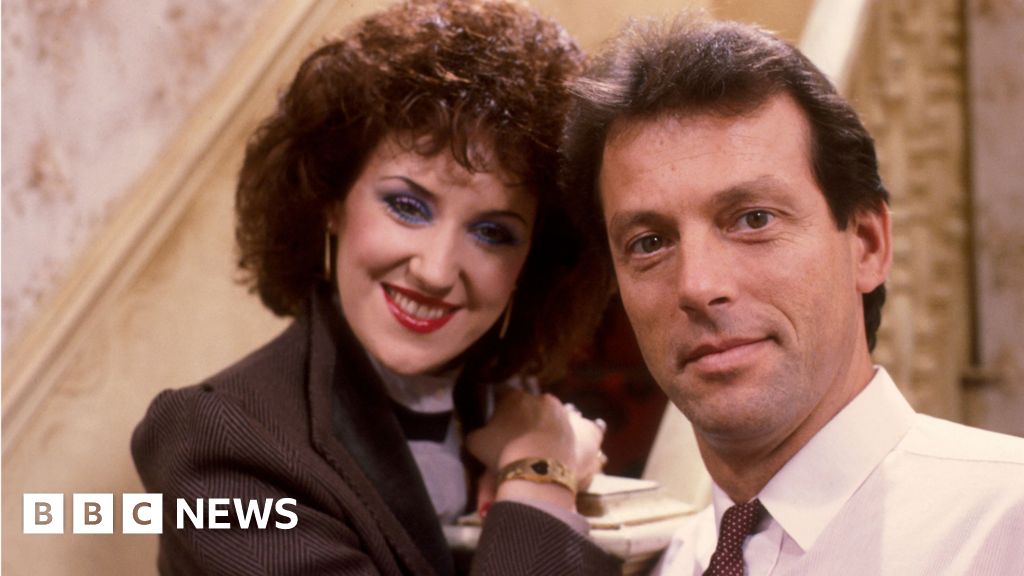How EastEnders was made, from doof doofs to Angie and Den
- BBC News
For 40 years, EastEnders has shown us life in a fictional community in East London - but from the iconic characters to the theme tune, could it all have been very different?
In the early research stages of EastEnders, multiple cities were considered for the new soap, from Manchester to London to Birmingham, according to BBC archive documents.
But one audience report recommended that a serial set in a working-class neighbourhood in London would probably have the most widespread appeal.
This would also set the soap apart from other big series of the time, like Coronation Street (set in Greater Manchester), Emmerdale Farm (set in Yorkshire) and Crossroads (set in a Midlands motel).
Though EastEnders creators Julia Smith and Tony Holland would eventually settle on the fictional Walford with its E20 postcode, at this point the show had a working title of East 8 - and it was to be based on a real street in the London borough of Hackney.
In March 1984, Smith and Holland headed to Lanzarote for a working holiday where they created 23 character biographies, three years of storyline overviews and 20 detailed story breakdowns.
Despite all their planning, however, some of the most important elements of EastEnders were last-minute accidents, including the iconic drum "doof doofs" in the theme tune, which have since become shorthand for the shows dramatic cliffhangers.
"In those days, if a theme tune was popular, youd often release it as a single. So I would make longer versions of the themes to allow for that," says Simon May, the theme tunes composer, who would go on to write EastEnders-related singles for cast members Anita Dobson and Nick Berry.
"The longer version gets a bit more Cockney, so I asked the drummer to play something to transition into the end theme. He played those doof doofs and Tony and Julia happened to be in the studio at the time.
"They said: We love that drum thing."
Another key ingredient of the early years of EastEnders also happened at the last minute: the pairing of the actors behind Angie and her bad-boy husband Den Watts, played by Leslie Grantham.
After a read-through of the first six episodes, the producers thought that original Angie Watts actress Jean Fennell was not quite working in the role. Anita Dobson took on the character at the last minute.
Actor and stuntman Derek Martin, who joined the soap 15 years later as Charlie Slater, explains he was also up for the role of Den.
"Leslie got it, and he was very good, he was the ladies man, and I was more the hard man," the 91-year-old actor says.
This pairing of Angie and Den proved popular with the public - and the Christmas Day 1986 episode that sees Den serve Angie divorce papers remains the only scripted programme to have been watched by more than 30 million people in the UK, according to Barb figures.
The first episode of EastEnders was broadcast on 19 February 1985, with 17 million people watching - making it the second most-watched episode on the BBC that week behind The Two Ronnies.
This compared to the 18 million who watched the same weeks Coronation Street.
The episode started with a kick, as Den broke down a door to find the nearly dead body of Reg Cox (played by Johnnie Clayton) - and ended with a punch, as suspect number one in the attack, Nick Cotton (John Altman), put his fist through the glass of the Queen Vic doors.
Though the press was quick to set up a rivalry between EastEnders and Coronation Street, the cast had their eye on another ITV soap.
Actor Adam Woodyat, who played Ian Beale in that first episode, says: "We were going out at the same time as Emmerdale Farm at 7pm. It felt like Emmerdale Farm gave us an absolute kicking in the ratings until they shifted us to half past seven."
Newspapers of the time suggested reactions were mixed. A Sunday People poll of 600 viewers showed 56% of respondents didnt like the first episode, with complaints over "coarse" and "bawdy" dialogue.
The Guardian, however, was more measured, with their critic Hugh Hebert predicting it would "probably take a year before anyone knows whether the BBC has got it right".
The show would prove itself earlier than that. On 25 July 1985, the programme was the most-watched on the BBC that week. This coincided with the shows first blockbuster storyline that saw Michelle (played by Susan Tully) become pregnant by a mystery man, eventually revealed to be Den Watts.
"After the reveal of Den and Michelle," says Woodyat, "thats when we started to realise we might have something here."